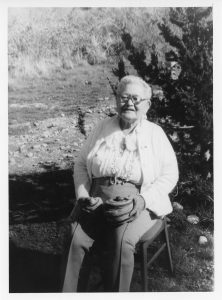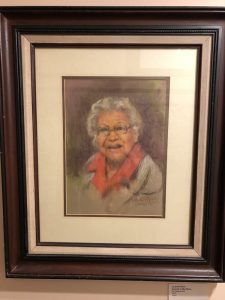Ida’s Influence
Granny Ida taught my mother how to dry, dye and weave with the tall beach grass when she was very young. Ida would sing and speak to her children, grandchildren and great grandchildren in our [SENĆOŦEN] language… She could explain which organisms were safe to eat and how to catch and prepare for a meal, or how to preserve for the winter months… While they kept their hands busy, they listened to the teachings.
Trena Lynn Sutton

Ida Planes with her handcrafted baskets, at the Cooper home on T’Sou-ke First Nation Reserve, March 1978.
Women have shaped the young minds of the region through hands-on, experiential education.
Pre-Contact, the indigenous peoples of the region educated their young through demonstration, group socialization, participation in spiritual rituals, and skill development alongside oral teachings.
In T’Sou-ke culture, knowledge is passed in a special way. In a notable example, Ida Planes, a T’Sou-ke elder, would take her grandchildren down to Siaosun [the T’Souke Nations’ second and largest village] to help pick the tall grass that grows at the beach, imparting lessons as they worked.
For Trena Sutton, great granddaughter of Ida, this way of learning influenced her teaching style and the way she planned her curriculum for her students. She says it is a natural way for children to learn, through multitasking and engaging with lessons in a physical, intellectual, and spiritual way.
Ida was a charming story teller, and shared much practical knowledge with the world. She was the last fluent speaker of the T’Sou-ke dialect of the Straits Salish, or SENĆOŦEN, language.
Below is an excerpt from an interview with Granny Ida Planes from the Sooke Region Museum Collection, made in 1977. Learn some T’Sou-ke words as you listen along!
Listen to the audio clip with transcript: “Ida Speaking T’Sou-ke”


